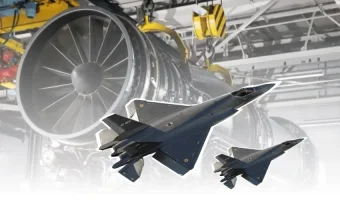- Views: 6K
- Replies: 42
In a significant development for India's military aviation future, aerospace giant Rolls-Royce has confirmed its offer to co-develop a new jet engine for the nation's upcoming Advanced Medium Combat Aircraft (AMCA).
Company officials stated that the proposed 110 kilonewton (kN) thrust engine would be a completely original design, specifically created for India's requirements and separate from the engine Rolls-Royce is developing for its own contributions to sixth-generation fighter programs like the Global Combat Air Programme (GCAP).
Crucially, Rolls-Royce emphasised that India would retain full Intellectual Property Rights (IPR) for this bespoke engine. While some advanced technologies might be shared, the fundamental design and thrust capacity will differ considerably from Rolls-Royce's other next-generation projects.
The AMCA represents India's ambitious step into the 5.5-generation stealth fighter category, spearheaded by the DRDO and the ADA. This advanced aircraft requires a sophisticated propulsion system capable of sustained supersonic flight without afterburners (supercruise), features optimized for stealth, and superior agility.
Rolls-Royce's proposal for a 110kN engine directly addresses these needs. By offering an engine designed "from scratch," rather than adapting an existing model, the company aims to provide a powerplant perfectly matched to the AMCA's specific operational and strategic profile. Mastering jet engine technology is seen as a critical step for any nation aspiring to advanced aerospace capabilities.
Officials highlighted that the engine's power specifications – 110kN of "wet" thrust (with afterburner) and potential for growth to 120-130kN – are distinct from the engine being developed for the GCAP initiative involving the UK, Italy, and Japan.
GCAP sixth-generation engine is expected to feature adaptive cycle technology, allowing variable performance for different flight stages, and cater to future needs like powering energy-intensive systems. In contrast, the engine proposed for India's AMCA focuses on delivering a robust balance of power, dependability, and adaptability suitable for a 5.5-generation fighter, while supporting India's long-term technological goals in aerospace.
A major highlight of the Rolls-Royce offer is the promise of complete IPR transfer to India. This assurance means India would fully own the engine's design blueprints, manufacturing techniques, and the rights to undertake future modifications and upgrades independently. This aligns strongly with India's 'Atmanirbhar Bharat' initiative, aiming to reduce dependency on foreign defence technology.
Unlike previous collaborations where intellectual property often remained with the overseas partner, this proposed arrangement would empower India's Gas Turbine Research Establishment (GTRE) and local industries to control, enhance, or potentially export the engine technology without external permissions.
This ownership promise reportedly includes sharing not just the manufacturing methods ("know-how") but also the underlying engineering principles ("know-why"). Equipping Indian engineers with this deeper understanding is vital for fostering genuine indigenous innovation.
Such comprehensive technology transfer could significantly boost India's aerospace sector, potentially benefiting other indigenous projects like the Tejas Mk2 fighter, the planned Twin Engine Deck-Based Fighter (TEDBF) for aircraft carriers, and perhaps even a future Indian sixth-generation aircraft program.
While stressing the unique nature of the proposed AMCA engine, Rolls-Royce indicated that select cutting-edge technologies being researched for sixth-generation platforms could be incorporated.
This might involve advanced heat-resistant materials, enhanced fuel efficiency measures, or specialized nozzle designs to minimize heat signatures, thereby improving stealth and overall performance.
However, these would be specific features adapted for the AMCA, not the full, complex architecture of a sixth-generation adaptive cycle engine. An official clearly stated, "Technically and in thrust parameters, they are totally different beasts."
The proposed engine is expected to generate around 75kN of "dry" thrust (without afterburner), enabling the crucial supercruise capability expected of modern fighters. A modular construction, potentially drawing from Rolls-Royce's advanced research, could also simplify maintenance and future upgrades, helping keep the AMCA fleet effective over its decades-long service life.
This contrasts with true sixth-generation engines, which are anticipated to exceed 130kN thrust and incorporate variable cycle technology to manage a wider range of operational demands, including support for unmanned companion aircraft and advanced weapon systems.
Rolls-Royce's proposal enters a competitive field, with France's Safran and America's General Electric (GE) also vying to partner with India for the AMCA engine.
Safran is offering an engine derived from its Rafale fighter's M88 engine family with full technology transfer, while GE has proposed an enhanced version of its widely used F414 engine.
Rolls-Royce seeks to distinguish its bid by offering a purpose-built design combined with complete intellectual property ownership, appealing directly to India's strategic objectives of technological independence and flexibility.
The AMCA project aims for a first flight around 2029-2030, with squadron service planned by 2035. Initial prototypes and the first production batch (Mk1) are slated to fly using imported GE F414 engines (rated at 98kN).
The more powerful, co-developed 110kN engine is intended for the subsequent AMCA Mk2 variant. This progression aligns with DRDO Chairman Dr. Samir V. Kamat's stated goal of developing a propulsion system that can serve the AMCA effectively and potentially evolve to power future Indian fighter aircraft, ensuring India is not reliant on foreign suppliers for critical defence technologies in the long run.



